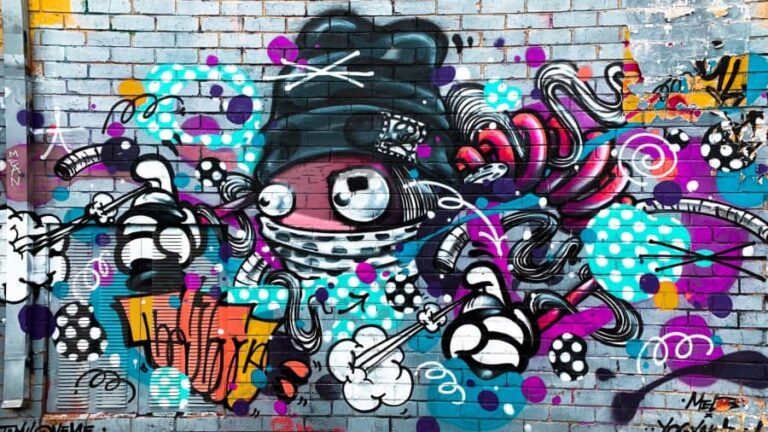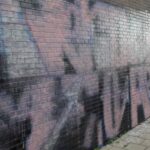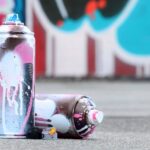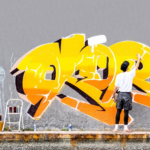Types of Street Art:
A Comprehensive Guide
-
Ko van den Boom
- Reading time: 25 minutes
- Guides, Street art

This blog post about the types of street art aims at creating an overview specifically of the most
prominent styles of street art in the western world. We emphasize this focus here in order to
acknowledge that there is much more artistic creations, movements and subcultures in the rest of the world which we will not present here. Moreover we need to emphasize that we will be looking at the types of street art from the perspective of visual styles. If you’re interested in street art as a wider phenomenon (it’s history and socio-cultural implications) you should read the blog post entitled What is street art? An overview.
Don’t conflate the concepts “street art” and “graffiti”
Street art has become a significant cultural phenomenon, transforming urban landscapes and
engaging communities worldwide. While many people often conflate street art with graffiti, it is
essential to understand that the two do not represent the same concept – even though there is some overlap.
Graffiti is a specific form of street art characterized by spray-painted or drawn markings, often
with a focus on lettering and tags.
- Street art on the other hand encompasses a broader spectrum of artistic expressions,
including murals, stencils, and installations that communicate messages, provoke thought, or beautify public spaces.
This guide will explore the various types of street art, highlighting their unique characteristics and significance in contemporary culture.
Graffiti as street art
Graffiti is perhaps the most recognized form of street art. Originating in the late 1960s in some
American urban areas, it involves the use of spray paint or markers to create images or text on
various surfaces. It often serves as a means of expression for artists who wish to convey their
thoughts, emotions, or social commentary. It can take many forms, from simple tags—stylized
signatures of the artist—to elaborate murals that cover entire buildings. While some view graffiti as
vandalism, others appreciate its role in challenging societal norms and providing a voice to
marginalized communities. The debate surrounding graffiti often centers on legality versus artistic
freedom, making it a complex topic within the broader realm of street art
Contents
Ko van den Boom
Main Categories
Related articles
Main Categories
Murals: large scale street art
Murals are large-scale paintings that can be found on walls in urban environments. Unlike graffiti, which is often created without permission, murals are frequently commissioned by property owners or local governments to beautify neighborhoods or convey specific messages. Murals can range from
abstract designs to detailed representations of cultural narratives and historical events. The significance of murals lies not only in their aesthetic appeal but also in their ability to foster community engagement. Many murals are created through collaborative efforts involving local artists and residents, promoting a sense of ownership and pride within the community. Additionally, murals can serve as platforms for social commentary, addressing issues such as inequality, environmental
Stencil Art, the art templates
Stencil art is a technique that involves creating images using pre-cut templates or stencils. This method allows artists to reproduce their work quickly and efficiently while maintaining precision in their designs. Stencil art gained popularity in the 1980s and 1990s, with artists like Banksy bringing it into the mainstream. One of the defining characteristics of stencil art is its ability to convey powerful messages succinctly. The simplicity of the medium allows for striking visuals that often address social or political issues. Stencil art can be found in various urban settings, from alleyways to prominent public spaces, making it an accessible form of expression for both artists and audiences. Since stencil art can be created really quickly (because of pre-made templates) it is often used illegally for guerrilla-style actions in urban areas.
3D Street art a.k.a. anamorphic art
3D street art, also known as anamorphic art, creates optical illusions that make two-dimensional images appear three-dimensional when viewed from specific angles. This innovative style has gained traction in recent years due to its ability to captivate viewers and encourage interaction.
Artists use techniques such as perspective manipulation and shading to create these illusions, often transforming sidewalks and streets into immersive experiences. 3D street art not only entertains but also challenges perceptions of space and reality within urban environments. It invites viewers to engage with their surroundings creatively and playfully
Sticker Art
Sticker art involves the use of adhesive stickers featuring images or messages placed in public spaces. This form of street art is characterized by its accessibility; anyone can create stickers and share them with the world. Sticker artists often use humor or irony to convey their messages, making this medium an effective tool for social commentary. Sticker art has become a popular form of expression among grassroots movements and subcultures, like skateboarders, punk-rock and hard-core music fans etc. Artists often engage in “sticker bombing,” where they cover surfaces with numerous stickers to create visual impact. While sticker art may be ephemeral, its ability to spark conversations about various topics makes it a valuable component of the street art landscape.
Poster Art a.k.a. Wheatpasting
Poster art involves creating large posters that are pasted onto surfaces using wheatpaste—a mixture of flour and water—allowing artists to share their work quickly across urban environments. This technique has historical roots in political activism but has evolved into a popular form of street art that addresses a host of themes Wheatpasting allows artists to disseminate their messages widely while maintaining a level of anonymity. The posters can feature anything from intricate illustrations to bold typography, often conveying social issues or promoting events. The temporary nature of poster art adds an element of urgency; once pasted up, these works may be removed or deteriorate over time, prompting artists to continually create new pieces.
Public space sculptures
Sculptures in public spaces represent a unique form of street art that goes beyond traditional two-dimensional expressions. These three-dimensional works can be made from various materials—metal, wood, plastic—and are often installed without permission in urban environments.Sculptural street art challenges viewers’ perceptions by introducing unexpected elements into familiar settings. Artists may use found objects or repurpose materials to create thought-provoking
installations that engage with themes such as consumerism, environmentalism, or social justice. The presence of sculptures encourages viewers to interact with their surroundings differently and prompts discussions about public space usage
Guerrilla Art
Guerrilla art refers to spontaneous and unauthorized installations designed to provoke thought or raise awareness about social issues. This form of street art is characterized by its subversive nature; artists often employ unconventional methods and materials to challenge societal norms.
Guerrilla artists aim to disrupt everyday life by placing unexpected artworks in public spaces—whether through flash mobs, temporary installations, or interactive performances. This approach allows them to bypass traditional gallery systems and engage directly with audiences on the streets.
The impact of guerrilla art lies in its ability to inspire dialogue about pressing issues while fostering creativity within communities
Environmental Art
Video Projections as a form of Street art
Video projections have emerged as an innovative form of street art that utilizes technology to create
dynamic visual experiences in urban spaces. Artists project videos onto buildings or other surfaces during events or installations, transforming ordinary environments into immersive artworks.
This relatively new medium allows for storytelling through moving images combined with soundscapes, engaging audiences on multiple sensory levels. Video projections can address various themes—from social justice issues to personal narratives—capturing attention in ways static artworks cannot achieve alone. As technology continues to evolve, it is likely that video projections will play an increasingly prominent role in the realm of street art.
Mixed media street art, combinations of approaches and materials
Conclusion
To conclude our summary of street art styles
All types of street art need protection
Protecting legal street artworks ensures that communities retain access not only to aesthetically pleasing environments but also to powerful narratives that are born within these communities. Legal street art enriches public spaces and infrastructure for a short (installations) or longer span of time (for example murals) by giving them meaning outside or beyond their usual function.
Those types of street art than can be protected, should be, and we have a lot to say about this topic as well. Read our post about the various methods of protection of street art. If you are interested in specific, heavy duty protective coatings go to Mavro International’s website (section about coatings),
or (if you are looking for a specific professional protective coating) go to Mavro International’s webshop and get to know the professional line of anti-graffiti coatings called Graffitiguard.




